
Marine Fighter Attack Squadron 323 (VMFA-323) is an aircraft carrier-based aviation squadron of the United States Marine Corps. The squadron is equipped with the McDonnell Douglas F/A-18C Hornet and is based at Marine Corps Air Station Miramar, California, United States. It falls under the command of Marine Aircraft Group 11 (MAG-11) and the 3rd Marine Aircraft Wing but deploys with the U.S. Navy's Carrier Air Wing 17 (CVW-17). Their tail code is WS and their radio callsign is Snake.

The 3rd Marine Aircraft Wing is the major west coast aviation unit of the United States Marine Corps. It is headquartered at Marine Corps Air Station Miramar, in San Diego, California and provides the aviation combat element for I Marine Expeditionary Force. The wing is made up of a headquarters squadron, four flying groups, an aviation command and control group and an aviation engineering group.
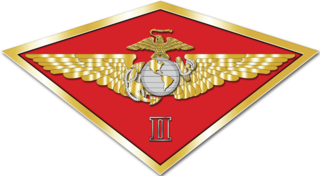
The 2nd Marine Aircraft Wing is the major east coast aviation unit of the United States Marine Corps and is headquartered in Marine Corps Air Station Cherry Point, North Carolina. The Wing provides the aviation combat element for the II Marine Expeditionary Force.

Marine Attack Squadron 231 (VMA-231) is a United States Marine Corps fixed wing attack squadron that consists of AV-8B Harrier (V/STOL) jets. The squadron, known as the "Ace of Spades", is based at Marine Corps Air Station Cherry Point, North Carolina and fall under the command of Marine Aircraft Group 14 (MAG-14) and the 2nd Marine Aircraft Wing.
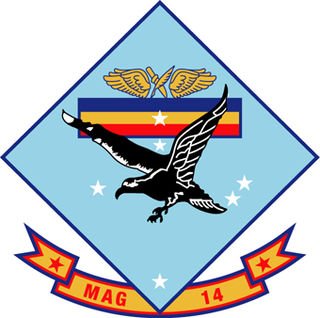
Marine Aircraft Group 14 (MAG-14) is a United States Marine Corps aviation unit based at Marine Corps Air Station Cherry Point, North Carolina that is currently composed of two AV-8B Harrier squadrons, one F-35B squadron, one UAV training squadron, one KC-130 squadron, and an aviation logistics squadron.

Marine Aircraft Group 31 (MAG-31) is a United States Marine Corps aviation group based at Marine Corps Air Station Beaufort, South Carolina that is currently composed of two F/A-18C Hornet squadrons, one F/A-18A++ Hornet squadron, two F/A-18D Hornet squadrons, one F-35B Lightning II training squadron, and an aviation logistics squadron. It falls under the command of the 2nd Marine Aircraft Wing.

Marine Fighter Attack Squadron 312 (VMFA-312) is a United States Marine Corps F/A-18C Hornet squadron. Also known as the "Checkerboards", the squadron is based at Marine Corps Air Station Beaufort, South Carolina and falls under the command of Marine Aircraft Group 31 (MAG-31) and the 2nd Marine Aircraft Wing. The Radio Callsign is "Check."

Marine Fighter Attack Squadron 242 (VMFA-242) is a United States Marine Corps squadron flying F-35B Lightning II STOVL Stealth Fighter. The squadron, known as the "Bats", is based at Marine Corps Air Station Iwakuni, Japan and falls under the command of Marine Aircraft Group 12 (MAG-12) and the 1st Marine Aircraft Wing. The radio callsign is "Profane".
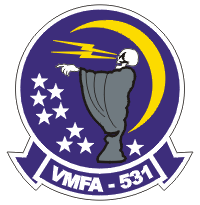
Marine Fighter Attack Squadron 531 (VMFA-531) was a United States Marine Corps fighter squadron consisting of various types aircraft from its inception culminating with the F/A-18 Hornet. Known as the "Grey Ghosts", the squadron participated in action during World War II and the Vietnam War. They were decommissioned on 27 March 1992.

Marine Air Control Squadron 1 (MACS-1) is a United States Marine Corps aviation command and control squadron. The squadron provides aerial surveillance, air traffic control, ground-controlled intercept, and aviation data-link connectivity for the I Marine Expeditionary Force. It was the first air warning squadron commissioned as part of the Marine Corps' new air warning program and is the second oldest aviation command and control unit in the Marine Corps. The squadron is based at Marine Corps Air Station Yuma and falls under Marine Air Control Group 38 and the 3rd Marine Aircraft Wing.

Marine Air Control Group 28 (MACG-28) is a United States Marine Corps aviation command and control unit based at Marine Corps Air Station Cherry Point that is currently composed of four command and control squadrons and a low altitude air defense battalion that provide the 2nd Marine Aircraft Wing with airspace coordination, air control, immediate air support, fires integration, air traffic control (ATC), radar surveillance, aviation combat element (ACE) communications support, and an integrated ACE command post in support of the II Marine Expeditionary Force.

Marine Air Control Squadron 2 (MACS-2) is a United States Marine Corps aviation command and control squadron. The squadron provides aerial surveillance, Ground-controlled interception, and air traffic control for the II Marine Expeditionary Force. They are based at Marine Corps Air Station Cherry Point and fall under Marine Air Control Group 28 and the 2nd Marine Aircraft Wing.

Marine Attack Squadron 331 (VMA-331) was an attack squadron in the United States Marine Corps. The squadron, also known as the "Doodlebugs" and "Bumblebees," was part of Marine Aircraft Group 31, 2nd Marine Aircraft Wing and was based out of Marine Corps Air Station Beaufort, South Carolina. The squadron fought in World War II and Operation Desert Storm. It was decommissioned as part of the post Cold War drawdown of the US Military on 1 October 1992.

Marine Air Control Squadron 5 (MACS-5) was a United States Marine Corps aviation command and control squadron. The squadron provided aerial surveillance and early warning while it was active from 1944 through 1993. They were last based at Marine Corps Air Station Beaufort, South Carolina and fell under the command of Marine Air Control Group 28 (MACG-28) and the 2nd Marine Aircraft Wing.

Marine Air Control Squadron 7 (MACS-7) was a United States Marine Corps aviation command and control squadron. The squadron provided aerial surveillance and ground-controlled interception and saw action most notably during the Battle of Okinawa in World War II and the Vietnam War. They were last based at Marine Corps Air Station Yuma and fell under the command of Marine Air Control Group 38 (MACG-38) and the 3rd Marine Aircraft Wing.
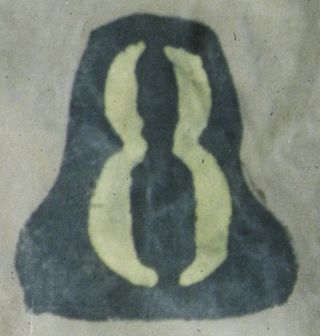
Air Warning Squadron 8 (AWS-8) was a United States Marine Corps aviation command and control unit that provided aerial surveillance and early warning of enemy aircraft during World War II. The squadron was commissioned on 3 March 1944 and was one of five Marine Air Warning Squadrons that provided land based radar coverage during the Battle of Okinawa in 1945. AWS-8, utilizing the callsign "Arsenic," remained on Okinawa as part of the garrison force following the Surrender of Japan. The squadron departed Okinawa for the United States in February 1946 and was quickly decommissioned upon its arrival in California. To date, no other Marine Corps squadron has carried the lineage and honors of AWS-8 to include Marine Air Control Squadron 8 (MACS-8).
Air Warning Squadron 6 (AWS-6) was a United States Marine Corps aviation command and control unit that provided aerial surveillance and early warning of enemy aircraft during World War II. The squadron was activated on 1 January 1944 and was one of five Marine Air Warning Squadrons that provided land based radar coverage during the Battle of Okinawa in 1945. AWS-6 remained on Okinawa as part of the garrison force following the Surrender of Japan. The squadron departed Okinawa for the United States in February 1946 and was quickly decommissioned upon its arrival in California. To date, no other Marine Corps squadron has carried the lineage and honors of AWS-6 to include Marine Air Control Squadron 6 (MACS-6).
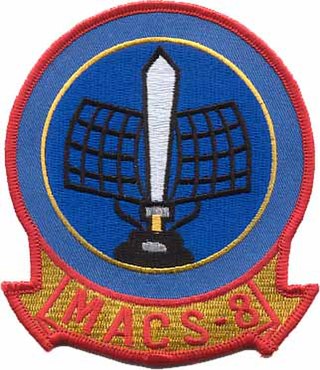
Marine Air Control Squadron 8 (MACS-8) was a United States Marine Corps aviation command and control squadron. The squadron provided aerial surveillance and ground-controlled interception (GCI). Originally formed in World War II as Air Warning Squadron 18 (AWS-18), the squadron served as a training and replacement unit until it was decommissioned in April 1947 as part of the post war drawdown of forces. Reactivated in 1952 during the Korean War the squadron took part in numerous Far East deployments during the 1960s. Transferred to Japan in 1969, the squadron was decommissioned in 1971 as the last Marine Corps units were departing South Vietnam. They were last based at Marine Corps Air Station Futenma, Okinawa, Japan and fell under the command of Marine Air Control Group 18 (MACG-18) and the 1st Marine Aircraft Wing.
Assault Air Warning Squadrons were United States Marine Corps aviation command and control units formed during World War II to provide early warning, aerial surveillance, and ground controlled interception during the early phases of amphibious landing. These squadrons were supposed to be fielded lightweight radars and control center gear in order to operate for a limited duration at the beginning of any operation until larger air warning squadrons came ashore. Four of these squadrons were commissioned during the war with one, AWS(AT)-5, taking part in the Battle of Saipan. All four squadrons were decommissioned on 10 November 1944 because the Marine Corps was unable to field the required mobile radars. The "first in" capability that the Assault Air Warning Squadrons were supposed to provide was transferred to the Early Warning Teams that were added to the tables of organization for the regular air warning squadrons.
Air Warning Squadron 14 (AWS-14) was a United States Marine Corps aviation command and control squadron during World War II. The squadron's primary mission was to provide aerial surveillance and early warning of approaching enemy aircraft during amphibious assaults. Formed in June 1944, the squadron was one of a handful of air warning squadrons that was never able to deploy overseas during the war. The squadron was decommissioned shortly after the end of the war in November 1945. To date, no other Marine Corps squadron has carried the lineage and honors of AWS-14 to include the former reserve Marine Air Control Squadron 14 (MACS-14).


















